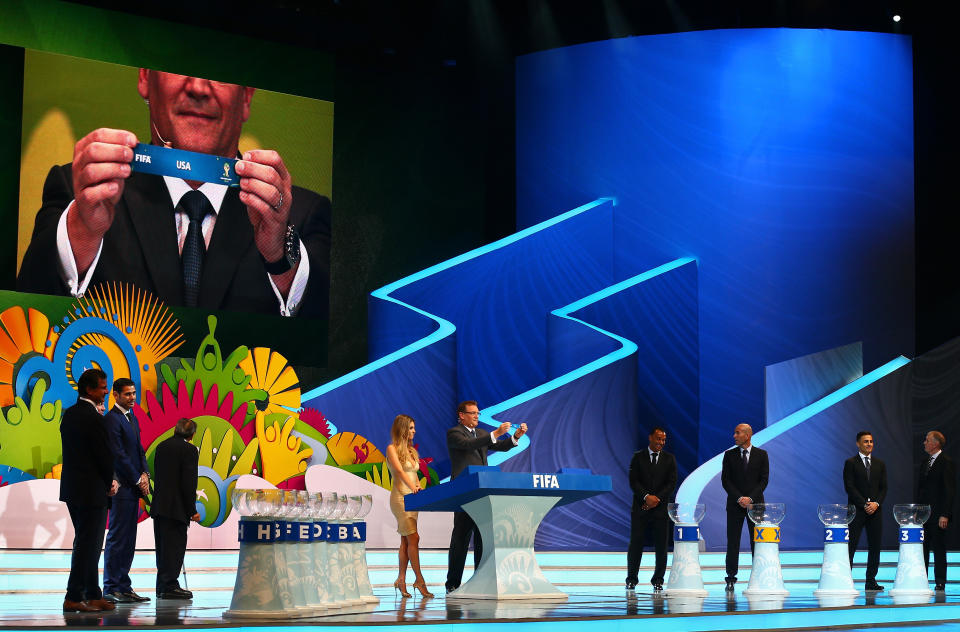FIFA changes World Cup draw seeding, which is good news for the U.S. ... except this year

Two-and-a-half months before the draw for the 2018 World Cup takes place in Moscow on Dec. 1, FIFA announced a fairly significant change to the event’s format.
Whereas in past years World Cup draws have been partially seeded, with the top eight teams in one pot and the remaining 24 separated by confederation, the 2018 World Cup draw will be fully seeded.
That means Russia and the top seven qualifiers in the October FIFA Rankings will go into Pot 1. The next eight highest-rated nations will go into Pot 2, the next eight into Pot 3, and the final eight into Pot 4. Geographic restrictions still apply – teams from the same region cannot be drawn alongside each other, except for European countries, which can go two-to-a-group – but the pots will be decided differently.
Here’s what this could hypothetically look like, based on the current World Cup qualifying landscape the FIFA Rankings:
POT 1: Russia, Germany, Brazil, Portugal, Argentina, Belgium, Poland, Switzerland
POT 2: France, Colombia, Spain, Peru, Mexico, England, Uruguay, Italy
POT 3: Croatia, Northern Ireland, Costa Rica, Sweden, Iran, USA, Egypt, Tunisia
POT 4: Serbia, Senegal, Japan, Nigeria, South Korea, Saudi Arabia, Ivory Coast, Panama
And, for comparison’s sake, here’s how that same hypothetical collection of 32 teams would have been divided up under the old format:
POT 1: Russia, Germany, Brazil, Portugal, Argentina, Belgium, Poland, Switzerland
POT 2: France, Spain, England, Italy, Croatia, Northern Ireland, Sweden, Serbia
POT 3: Colombia, Peru, Uruguay, Egypt, Tunisia, Senegal, Nigeria, Ivory Coast
POT 4: Mexico, Costa Rica, USA, Panama, Iran, Japan, South Korea, Saudi Arabia
The change is welcome, and in fact, it would have been great news for the United States in the past. The U.S. entered the 2006 World Cup seeded 9th, just one spot outside the top pot. But was placed in the weakest pot because CONCACAF and Asian sides were grouped together. So despite being fine margins away from a pot with Brazil, England, Spain, Germany, Mexico, France and Italy – and thus automatically avoiding those heavyweights in group play – the U.S. went into a pot with Trinidad and Tobago, Costa Rica, Serbia and Montenegro, Iran, Japan, Saudi Arabia and South Korea.
And the U.S. paid for the imperfect system back in 2006. The Yanks were placed in a group with eventual champion Italy, golden generation Czech Republic and emerging Ghana.
In 2010 and 2014 again, the U.S. would have been in Pot 2 had the draw been seeded 1-32. It entered 2010 seeded 11th and 2014 seeded 13th. The FIFA overlords were kind in 2010 anyway, but in 2014, the U.S. got stuck in a four-team round-robin with Germany, Portugal and Ghana. Had the draw been fully seeded, that group would have been impossible.
The issue is that, now that FIFA has finally decided to make a change that would presumably help the U.S., the Americans haven’t held up their end of the bargain. They currently sit 28th in the most recent FIFA Rankings. That would likely see them sneak into Pot 3, because several teams that currently rank ahead of the U.S. won’t qualify. So it’s unlikely to make a significant difference.
Of course, the bigger issue is that the U.S. is in a legitimate battle to qualify in the first place. It sits in fourth place in the final round of CONCACAF qualifying, level on points with Honduras and only ahead on goal differential. A fourth-place finish would send it to an intercontinental playoff against either Australia or Syria. It would have to finish third to qualify directly. It has two games remaining to leap-frog Panama, its opponent in the first of those two games.
FIFA’s alteration will help Mexico more than anybody. El Tri will almost certainly claim a place in Pot 2 alongside some European and South American heavyweights. Colombia, Uruguay, Chile or Peru – whoever among them qualify – will also benefit. The new format is most detrimental to African nations, such as the Ivory Coast and Nigeria, and the Asian qualifiers outside of Iran.
The broad issue with FIFA’s change is the criteria used to seed the teams. FIFA’s ranking system is flawed, and can be gamed by astute scheduling. That, in part, is why you see both Poland and Switzerland in the top seven. Another eyebrow-raiser is Wales, despite early qualification slip-ups, at No. 13, two spots behind No. 11 Spain, two ahead of No. 15 England, and four ahead of No. 17 Italy.
But the new system is certainly an improvement. It will make the draw slightly more convoluted, with new permutations introduced to ensure nations ultimately remain separated by continent. But that’s a logistical issue, not a competitive one. The 1-32 seeded format makes competitive sense.
– – – – – – –
Henry Bushnell covers soccer – the U.S. national teams, the Premier League, and much, much more – for FC Yahoo and Yahoo Sports. Have a tip? Question? Comment? Email him at henrydbushnell@gmail.com or follow him on Twitter @HenryBushnell.



